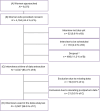Service preferences among postpartum women (non-)affected by different types of intimate partner violence: insights from the cross-sectional study INVITE
- PMID: 39748350
- PMCID: PMC11694455
- DOI: 10.1186/s12889-024-20921-y
Service preferences among postpartum women (non-)affected by different types of intimate partner violence: insights from the cross-sectional study INVITE
Abstract
Background: Women in the postpartum period are at greater risk of intimate partner violence (IPV), which may cause physical, sexual, or psychological harm and have a long-lasting negative impact on mother and child. Seeking help in case of IPV in the postpartum period can be difficult.
Objective: The purpose of this study was to examine service preferences among postpartum women in Germany (non-)affected by IPV.
Methods: In the cross-sectional study INVITE, postpartum mothers (n = 3,509) were interviewed via telephone. Using the WHO-Violence Against Women Instrument (WHO-VAWI), women were divided into groups: non-affected women and women affected by psychological, physical, and/or sexual IPV. Using analyses of variance, group differences regarding preferred services and modes of service provision were assessed. Examined service domains were psychosocial services (e.g., women´s shelter or self-help groups), medical services (e.g., gynecologist or emergency room), and midwives. Modes of service provision included direct communication (e.g., in person or video conference) and indirect communication (e.g., chat or e-mail).
Results: People from the women's social environment (e.g., family, friends) and specialized IPV services, such as women's shelters, were the most preferred support. Regarding service categories, women who experienced any type of IPV rated all three service domains less likely to be used than non-affected women. Most preferred provision mode was "in person". Women affected by physical and/or sexual IPV rated direct modes more negatively than non-affected women. However, there were no differences between (non-)affected women regarding indirect modes, such as e-mails or apps.
Discussion: The present results indicate that services were rated less likely to be used by postpartum women affected by IPV. Potential barriers which lead to these ratings need to be investigated. Efforts should be made to increase awareness of IPV and the beneficial effects of support.
Keywords: Cross-sectional study; Help seeking; INVITE study; Intimate partner violence; Postpartum period; Service preferences; Service provision.
© 2024. The Author(s).
Conflict of interest statement
Declarations. Ethics approval and consent to participate: This study, which involved human participants, was reviewed and approved by the Ethics Committee of the Technische Universität Dresden (No: EK 139042016). All methods were performed in accordance with the relevant guidelines and regulations. Consent for publication: Written informed consent was obtained from all participants. Competing interests: The authors declare no competing interests.
Figures



Similar articles
-
Treatment and counselling preferences of postpartum women with and without symptoms of (childbirth-related) PTSD: findings of the cross-sectional study INVITE.BMC Pregnancy Childbirth. 2024 Dec 31;24(1):885. doi: 10.1186/s12884-024-07061-2. BMC Pregnancy Childbirth. 2024. PMID: 39736602 Free PMC article.
-
Intimate partner violence after childbirth: an explanatory sequential mixed-methods study protocol.Reprod Health. 2024 Jun 11;21(1):84. doi: 10.1186/s12978-024-01825-x. Reprod Health. 2024. PMID: 38862986 Free PMC article.
-
Husband's Alcohol Use, Intimate Partner Violence, and Family Maltreatment of Low-Income Postpartum Women in Mumbai, India.J Interpers Violence. 2018 Jul;33(14):2241-2267. doi: 10.1177/0886260515624235. Epub 2016 Jan 21. J Interpers Violence. 2018. PMID: 26802047 Free PMC article.
-
Intimate partner violence and help-seeking--a cross-sectional study of women in Sweden.BMC Public Health. 2013 Sep 21;13:866. doi: 10.1186/1471-2458-13-866. BMC Public Health. 2013. PMID: 24053735 Free PMC article.
-
The Prevalence of Physical Intimate Partner Violence During Pregnancy and the Postpartum Period: A Systematic Review With Implications for Probable Violence-Caused Brain Injury Among Child Bearers.Trauma Violence Abuse. 2025 Jan 2:15248380241309292. doi: 10.1177/15248380241309292. Online ahead of print. Trauma Violence Abuse. 2025. PMID: 39744846 Review.
References
-
- European Union Agency for Fundamental Rights (FRA). Violence against Women: an EU-wide survey. Publications Office of the European Union Luxembourg. 2014.
-
- Jewkes R, Fulu E, Tabassam Naved R, Chirwa E, Dunkle K, Haardörfer R, et al. Women’s and men’s reports of past-year prevalence of intimate partner violence and rape and women’s risk factors for intimate partner violence: A multicountry cross-sectional study in Asia and the Pacific. PLoS Med. 2017;14(9):e1002381. - PMC - PubMed
-
- World Health Organization. Understanding and Addressing Violence Against Women: Intimate Partner Violence. World Health Organization 2012 [cited 2023 Feb 22]. Available from: URL: https://www.who.int/publications/i/item/9241593512.
Publication types
MeSH terms
LinkOut - more resources
Full Text Sources
Medical

